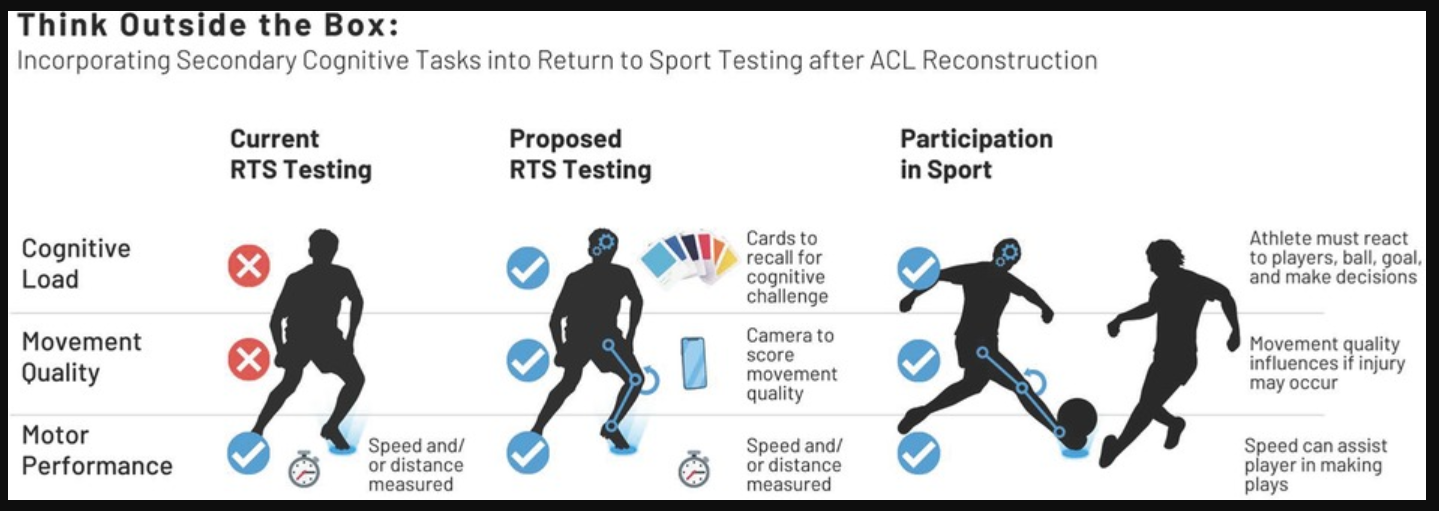Understanding Dual-Task Training & Why It’s Important to Incorporate in Your Practice
Dual-task training is a cognitive and physical exercise strategy that challenges individuals to perform two tasks simultaneously. This approach has gained significant attention in both performance training and rehabilitation for its potential to improve functional outcomes and overall efficiency. By integrating dual-task training, athletes and individuals in rehabilitation can enhance their cognitive and physical capabilities, leading to better performance and faster recovery. Here’s an in-depth look at what dual-task training involves and why it is crucial for optimizing performance and rehabilitation.
What is Dual-Task Training?
Dual-task training involves performing two distinct tasks at the same time—one physical and one cognitive. The primary goal is to improve the ability to manage multiple demands simultaneously, which reflects real-life situations where people often have to multitask, such as decision-making in sports.
Examples of Dual-Task Training:
Walking While Counting: An individual walks on a treadmill or around a track while simultaneously counting backwards or solving simple math problems.
Dribbling While Reciting: Individuals dribble a basketball or soccer ball while answering questions or engaging in conversation.
Exercise and Cognitive Challenges: Performing exercises like squats or lunges while reacting to visual or auditory stimuli, such as catching a ball or following verbal commands.
Why Dual-Task Training is Important
1. Enhancing Functional Performance
In real-world scenarios, individuals frequently engage in multitasking, whether it's an athlete strategizing in-game or a person managing daily activities while responding to environmental changes. Dual-task training mimics these conditions, helping individuals improve their ability to handle complex and dynamic situations.
Athletic Performance: For athletes, the ability to maintain physical performance while processing cognitive information is crucial. Dual-task training can enhance an athlete’s reaction time, decision-making, and overall game performance by simulating the cognitive demands of competitive play.
Daily Functioning: For non-athletes, especially older adults, dual-task training helps improve functional mobility and reduce the risk of falls. By practicing walking or other activities while performing cognitive tasks, individuals can better manage daily tasks and maintain independence.
2. Improving Cognitive and Motor Integration
Dual-task training enhances the integration of cognitive and motor processes, which is vital for both performance and rehabilitation.
Cognitive Processing: Performing cognitive tasks while engaging in physical activities can improve attention, memory, and executive function. This is particularly beneficial for individuals recovering from neurological conditions or brain injuries.
Motor Control: Engaging in dual-task training can enhance motor control and coordination. By challenging the brain to manage both cognitive and physical tasks, individuals can improve their overall movement efficiency and accuracy.
3. Promoting Neuroplasticity
Neuroplasticity is the brain’s ability to reorganize itself by forming new neural connections. Dual-task training stimulates neuroplasticity by challenging the brain in new ways.
Rehabilitation: In rehabilitation settings, dual-task training can promote recovery from injuries or neurological conditions by encouraging the brain to adapt and develop new strategies for managing motor and cognitive tasks.
Skill Acquisition: For athletes, incorporating dual-task training can facilitate skill acquisition by promoting the brain’s ability to process and respond to multiple stimuli simultaneously.
4. Enhancing Balance and Fall Prevention
For older adults and individuals recovering from injury, maintaining balance while performing daily tasks is essential.
Balance Training: Dual-task training can improve balance and stability by challenging individuals to maintain postural control while engaging in cognitive tasks. This can help reduce the risk of falls and improve overall mobility.
Functional Independence: By practicing dual-task scenarios, individuals can enhance their ability to perform everyday activities safely and efficiently, contributing to greater independence and quality of life.
5. Tailoring Training to Individual Needs
Dual-task training can be customized to meet the specific needs of individuals in both performance and rehabilitation settings.
Performance Training: Coaches and trainers can design sport-specific dual-task exercises that mimic the demands of competition, helping athletes enhance their multitasking abilities and overall performance.
Rehabilitation: Therapists can develop personalized dual-task programs that address specific cognitive and physical deficits, facilitating targeted and effective rehabilitation.
Implementing Dual-Task Training
To effectively integrate dual-task training into performance or rehabilitation programs, consider the following steps:
Assess Needs: Evaluate the individual’s current cognitive and physical abilities to determine appropriate dual-task challenges.
Design Exercises: Create dual-task exercises that are relevant to the individual’s goals and daily activities. Ensure that tasks are appropriately challenging but manageable.
Progress Gradually: Start with simpler dual-task combinations and gradually increase complexity as the individual improves.
Monitor and Adapt: Continuously monitor progress and adjust exercises based on performance and feedback.
Integrate into Routine: Incorporate dual-task training into regular practice or rehabilitation routines to maximize benefits.
This graphical abstract from Chaaban et al. proposes incorporation of dual-task training into return to sport testing after ACL reconstruction.
Conclusion
Dual-task training is a powerful approach for enhancing performance and facilitating rehabilitation by challenging the integration of cognitive and motor processes. Whether for athletes looking to improve game performance or individuals in rehabilitation aiming for better functional outcomes, dual-task training offers valuable benefits. By incorporating dual-task exercises into training or rehabilitation programs, individuals can improve their ability to multitask, enhance cognitive and motor skills, and achieve better overall results.

